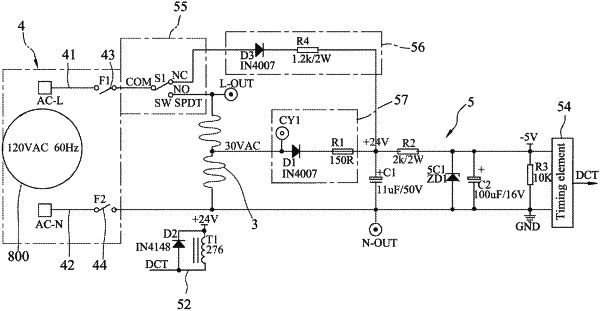| CPC A47J 37/0842 (2013.01) [H05B 1/0225 (2013.01)] | 7 Claims |

|
1. A toaster comprising:
an activation element configured to move between a turn-off position and a turn-on position;
an elastic element configured to provide a reaction force that drives said activation element to move from the turn-on position to the turn-off position;
a power circuit configured to connect to mains electricity to receive electrical power therefrom, said power circuit including a live wire, a neutral wire, a first switch connected with said live wire, and a second switch connected with said neutral wire, wherein said first switch and said second switch are configured to be turned on when said activation element is at the turn-on position;
a heating device; and
a control device electrically connected to said heating device and said power circuit, and configured to receive electrical power from said power circuit when said first switch and said second switch are turned on, said control device including:
an electromagnet;
a retaining element that is magnetically attractable and that is configured to move between a first position and a second position, to stay at the first position when not being magnetically attracted by said electromagnet, and to stay at the second position when being magnetically attracted by said electromagnet in order to hold said activation element at the turn-on position;
a timing element configured to count a time interval, and to control said electromagnet to continuously produce, only during the time interval, a magnetic force that attracts said retaining element to move to and be retained at the second position;
a two-state switch connected between said first switch of said power circuit and said heating device, and configured to be set at a first configuration and a second configuration when said retaining element is at the first position and the second position, respectively;
a first rectifier circuit connected between said two-state switch and a common node to which said electromagnet and said timing element are connected, and configured to, when said first switch and said second switch are turned on and when said two-state switch is at the first configuration where said two-state switch electrically connects said first switch and said first rectifier circuit, provide electrical power to said electromagnet and said timing element; and
a second rectifier circuit connected between said heating device and the common node, and configured to, when said first switch and said second switch are turned on and when said two-state switch is at the second configuration where said two-state switch electrically connects said first switch and said heating device, provide electrical power to said electromagnet and said timing element;
wherein said heating device is configured to, when said two-state switch is at the second configuration, convert electrical power received from said power circuit to thermal energy, and provide a fraction of the electrical power to said second rectifier circuit, and
wherein said timing element is further configured to:
in response to said activation element being moved to the turn-on position, be powered on by receiving electrical power from said first rectifier circuit, start counting the time interval, and control said electromagnet to produce the magnetic force to attract said retaining element to the second position, which in turn actuates said two-state switch to transition from the first configuration to the second configuration,
when said two-state switch is at the second configuration, receive electrical power from said second rectifier circuit, and control said electromagnet to continuously produce the magnetic force during the time interval, and
after the time interval has elapsed, control said electromagnet to stop producing the magnetic force, which in turn causes said retaining element to return from the second position to the first position, so that said activation element is released from the turn-on position and is moved to the turn-off position by the reaction force provided by said elastic element, and so that said two-state switch transitions from the second configuration to the first configuration to electrically disconnect said heating device from said first switch of said power circuit.
|